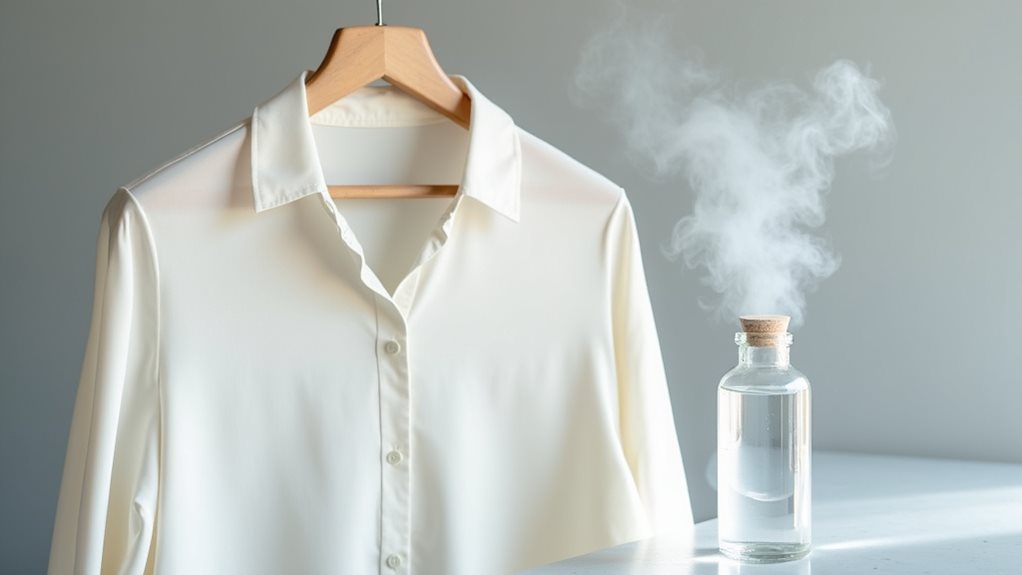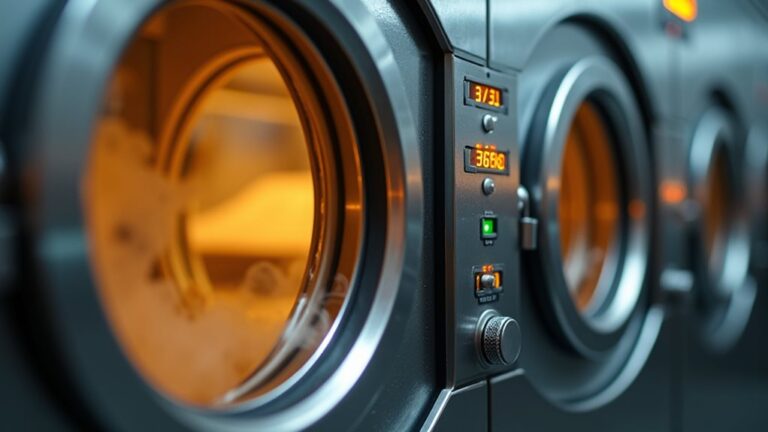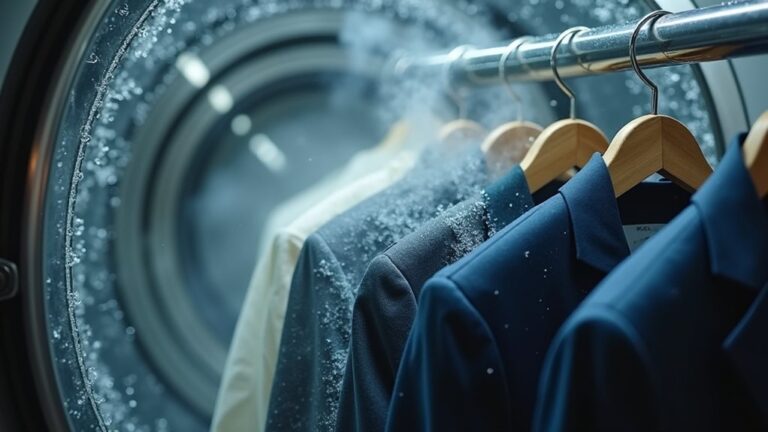Yes, dry cleaning absolutely cleans your clothes, just differently than your washing machine at home. Instead of water, it uses chemical solvents like perchloroethylene that excel at dissolving oil-based stains and dirt that water simply can’t touch. The process involves tagging, inspecting, pre-treating stains, then agitating solvents through fabrics before drying and pressing. It’s particularly effective on delicate materials like silk and wool, plus stubborn greasy stains that would survive your regular wash cycle, and there’s much more to discover about this fascinating cleaning science.
What Is Dry Cleaning and How Does It Work?
The mystery of dry cleaning has puzzled me since I first watched my wool blazer disappear behind that spinning carousel at the cleaners, wondering if those fancy machines actually did anything more than charge me twenty bucks for the privilege.
That twenty-dollar mystery behind the spinning carousel left me questioning whether dry cleaning was legitimate science or elaborate theater.
Here’s what actually happens: your garments get tagged, inspected for damage, then receive pre-treatment for stubborn stains before entering a specialized dry cleaning machine that’s basically a washing machine’s sophisticated cousin.
Instead of water, chemical solvents like perchloroethylene gently agitate delicate fabrics, lifting away oil-based dirt without the harsh soaking that would ruin your silk blouse.
The cleaning cycle effectively removes most stains, though water-based stains sometimes need special attention.
After cleaning, garments undergo solvent extraction and drying before professional pressing and steaming restore their original appearance.
The dry cleaning process genuinely works—it’s not merely expensive air freshening!
The Science Behind Dry Cleaning Solvents
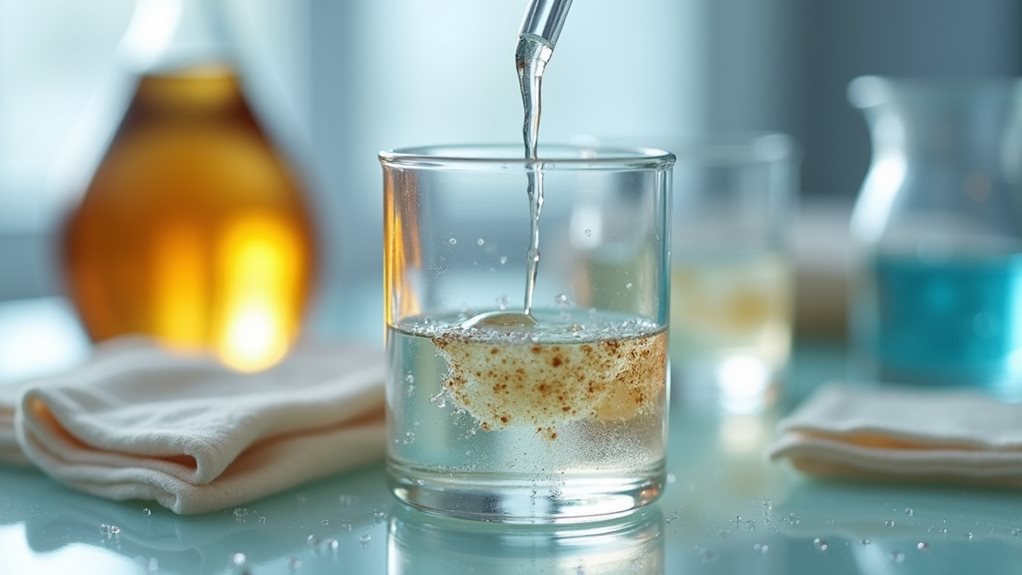
You’ve probably wondered what makes those dry cleaning solvents so effective at removing stubborn stains that your washing machine can’t touch, and it all comes down to the chemical principle that “like dissolves like” – meaning oil-based solvents naturally attract and dissolve greasy, oily stains without the harsh agitation that could damage your favorite silk blouse.
While perchloroethylene (perc) has been the industry standard for decades because it’s incredibly effective, many cleaners are now switching to gentler alternatives like siloxane or liquid CO2, which clean just as well without the health concerns that come with traditional solvents.
Other petroleum-based options like Stoddard solvent and petroleum spirits have also been used in dry cleaning operations, though they offer varying levels of cleaning effectiveness compared to perc.
The environmental impact of these cleaning methods varies dramatically, from perc’s potential groundwater contamination issues to newer green alternatives that break down safely, so understanding what your cleaner uses can help you make more informed choices about where to take your clothes.
How Solvents Work
When I first learned about dry cleaning solvents, I honestly thought they were just fancy soap alternatives, but the science behind how these chemicals work is surprisingly elegant and quite different from what happens in your washing machine.
The chemical structure of traditional dry cleaning solvents like perchloroethylene allows them to dissolve oil-based stains without actually penetrating your fabric’s fibers, which explains why your favorite silk blouse maintains its shape and texture.
During the dry cleaning process, your garments get gently agitated in these solvents, letting them tackle stubborn stains that regular detergent can’t touch.
Modern environmentally friendly solvents like siloxane offer this same cleaning method while being safer for you and the planet 🌍.
Other innovative alternatives include liquid carbon dioxide and hydrocarbon-based cleaners, which provide effective cleaning while addressing health and environmental concerns associated with traditional solvents.
Perc Vs Alternatives
Although perchloroethylene has dominated the dry cleaning industry for decades, I’ve watched with fascination as the tide turns toward safer alternatives, each bringing their own unique scientific advantages and trade-offs.
You’ll find perc still reigns supreme for dissolving stubborn oily stains, but environmental and health concerns have sparked innovation in cleaning solvents.
Siloxane breaks down into harmless sand and water (pretty cool, right?), though animal studies raise eyebrows about potential risks.
Liquid carbon dioxide offers impressive reusability and safety, but the expensive machinery makes my wallet weep just thinking about it.
Synthetic petroleum-based options provide middle-ground solutions, while eco-friendly cleaning methods continue gaining momentum as consumers demand safer alternatives for their beloved garments.
The ideal dry cleaning solvent must possess key properties including chemical stability, non-flammability, and the ability to effectively dissolve oils while remaining gentle on delicate fabric fibers.
Environmental Impact Concerns
Since discovering the darker side of dry cleaning chemistry, I’ve become genuinely troubled by the environmental footprint lurking behind those crisp, cleaned garments we love so much.
When you drop off your favorite blazer, you’re unknowingly contributing to a cycle where perchloroethylene seeps into groundwater, threatening community health for generations.
The dry cleaning process might recover 99.99% of solvents, but that remaining fraction accumulates over time, creating lasting environmental impact.
Fortunately, you can seek out green dry cleaning services that use eco-friendly alternatives like biodegradable detergents instead of traditional carcinogenic chemicals.
While some newer solvents still face scrutiny for potential carcinogenic effects, choosing establishments that prioritize environmental responsibility helps shift the industry toward cleaner practices 🌱.
Beyond groundwater contamination, the energy-intensive nature of traditional dry cleaning contributes significantly to carbon emissions, adding another layer to its environmental burden.
Which Fabrics and Stains Benefit Most From Dry Cleaning
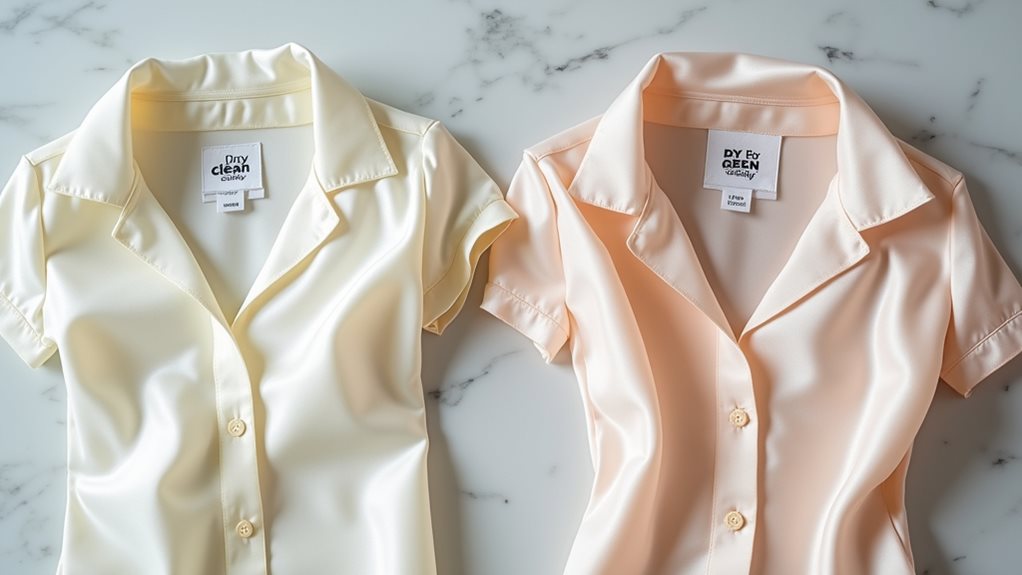
While most of us instinctively reach for the washing machine when our clothes need cleaning, certain fabrics practically beg for the gentler touch that only dry cleaning can provide.
Your silk blouses, wool sweaters, and velvet pieces will thank you for choosing this method, as water can cause irreversible damage to these delicate materials.
When it comes to stains, dry cleaning excels at tackling oil-based culprits like grease, food spills, and makeup mishaps that water simply can’t handle effectively.
Those gorgeous garments with sequins, lace, or intricate embellishments need this specialized care to maintain their beauty.
However, remember that water-based stains from coffee or wine require immediate attention, as dry cleaning won’t magically erase them later.
Professional dry cleaners use specialized solvents like perchloroethylene and eco-friendly alternatives that dissolve oils without causing the structural damage that water-based washing can inflict on sensitive fabrics.
Step-by-Step Breakdown of the Professional Dry Cleaning Process
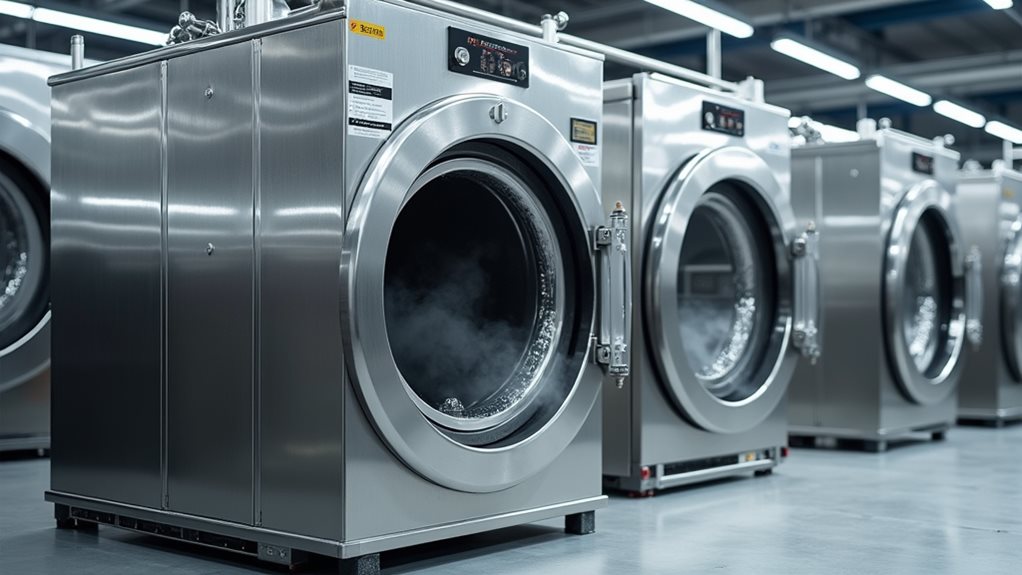
You’ve probably wondered what actually happens to your favorite blazer once it disappears behind that dry cleaner’s counter, and honestly, I used to imagine some mysterious cleaning fairy waving a magic wand until I learned the surprisingly methodical process that unfolds.
The process begins with careful preparation where your garments get tagged and inspected like precious cargo, followed by the main event where specialized solvents work their science-backed magic to lift away stubborn stains that would laugh in the face of your home washing machine.
During the cleaning cycle, your clothes are gently agitated in chemical solvents like perchloroethylene that dissolve oils and grease while the solvent gets filtered and distilled for reuse.
Finally, your clothes undergo a thorough quality check and get the royal treatment with professional pressing techniques that’ll make you look like you stepped off a magazine cover – well, assuming you’ve got the confidence to match!
Initial Garment Preparation Steps
Before your favorite blazer or delicate silk blouse even touches a drop of solvent, the dry cleaning professionals begin their meticulous dance of preparation, and honestly, watching this process unfold the first time reminded me of a medical procedure – methodical, precise, and oddly reassuring.
Your garment receives a unique identification tag for proper garment tracking throughout the entire cleaning process, because losing your grandmother’s vintage coat would be devastating.
Next comes the visual inspection, where trained eyes examine every inch for stains and forgotten treasures in pockets.
Each spotted stain gets pre-treated with specialized chemicals before your item enters the dry cleaning machine, where organic solvents work their magic, setting the stage for those perfect finishing touches.
The most common solvent used in this process is perchloroethylene, though many facilities are now switching to more environmentally friendly alternatives.
Solvent Cleaning Process
Once your garment disappears behind the counter, it begins what I like to call the “solvent spa experience,” though admittedly, that sounds way more luxurious than the industrial reality of the actual cleaning machine.
Your clothes, already pre-treated with chemicals during inspection, get loaded into a specialized drum that looks surprisingly similar to your home washer, except it uses organic solvents instead of water for the actual dry cleaning process.
The magic happens when perchloroethylene (perc) or other solvents gently agitate through the fabric, removing oil-based stains that water simply can’t touch.
After the cleaning cycle completes, there’s another garments inspection for quality control, guaranteeing every stubborn spot has surrendered to the solvent’s persistence.
Following the solvent cleaning, your garments undergo a drying phase and are carefully pressed to restore their original appearance and structured shape.
Final Inspection and Finishing
After your clothes emerge from their solvent bath looking refreshed but still slightly rumpled, they head to what I consider the “makeover station” of the dry cleaning world, where skilled technicians conduct a thorough second inspection that would make a detective proud.
This meticulous final inspection guarantees every stubborn stain has surrendered completely, while checking that your garments remain in proper condition without any battle scars from the cleaning process.
Next comes the satisfying transformation through pressing, ironing, or steaming – honestly, watching wrinkles disappear never gets old!
The pressing and finishing stage is particularly crucial for structured components like suit jackets and tailored garments, as it restores their original shape and professional appearance that water-based washing simply cannot achieve.
Finally, each piece gets wrapped in protective plastic like a precious gift, assuring that when you collect your clothes, they’ll look absolutely perfect and ready to make you feel confident again, customer.
Advantages and Limitations of Dry Cleaning Vs Traditional Washing
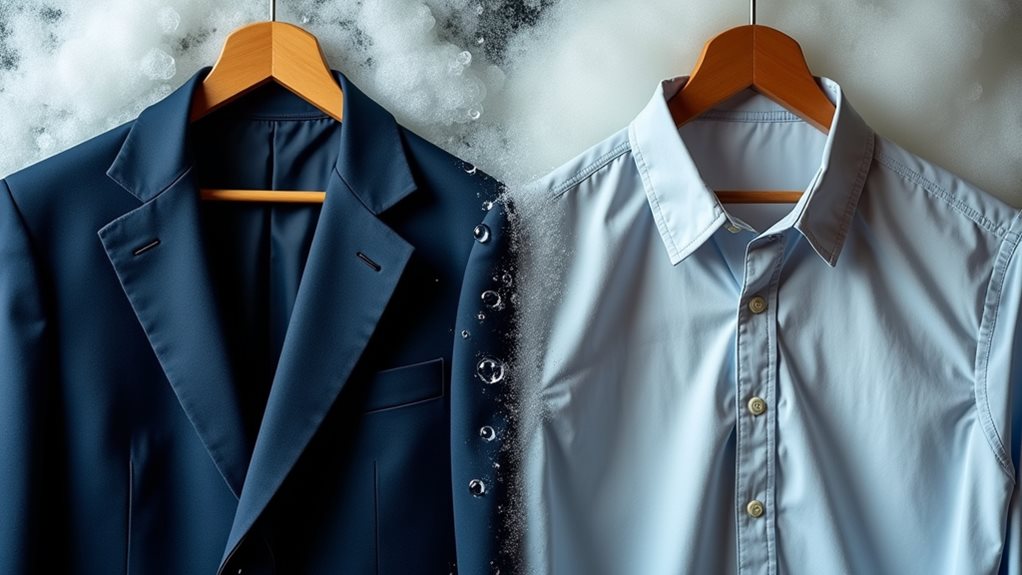
When you’re standing in your closet holding that expensive silk blouse with a mysterious grease stain, you’ll quickly discover that choosing between dry cleaning and your trusty washing machine isn’t just about convenience—it’s about understanding what each method can and can’t do for your clothes.
Dry cleaning excels at tackling oil-based stains and preserving delicate fabrics like wool and silk, using specialized solvents that won’t damage garment structure the way traditional washing might.
However, it’s surprisingly ineffective against water-based stains like coffee spills, where your regular washer actually shines.
The cost of dry cleaning—typically $3-10 per item—makes effective cleaning decisions essential, especially when you realize that choosing the wrong method could ruin your favorite pieces forever.
Environmental Impact and Modern Eco-Friendly Alternatives

While making smart cleaning choices for your wallet matters, there’s another side to this story that might keep you up at night—the environmental impact of traditional dry cleaning methods.
You see, conventional dry cleaning relies heavily on perchloroethylene, a chemical that’s basically the villain in this eco-story, classified as a probable human carcinogen that wreaks havoc on our planet.
Thankfully, modern dry cleaners are embracing sustainable practices through innovative eco-friendly alternatives:
- Liquid carbon dioxide cleaning that transforms CO2 into a powerful, non-toxic solvent
- Green dry cleaning using biodegradable detergents and water-based solutions
- Energy-efficient machines that recycle solvents, dramatically reducing waste
Consumer demand is pushing this green revolution forward, proving that you can have spotless clothes without compromising your environmental values! 🌱
Tips for Maximizing Your Dry Cleaning Results

Since you’ve made the smart choice to go green with your dry cleaning, let’s talk about how to actually get the best results from this investment—because honestly, there’s nothing more frustrating than spending good money only to pick up clothes that still look questionable.
First things first: always check those garment labels to confirm dry cleaning is actually recommended, since some fabrics hate solvents more than I hate Monday mornings 😅.
When you drop off your clothes, tell your cleaner about specific stains and their sources—that coffee spill needs different pre-treatment than wine.
Skip at-home cleaning methods on delicate features, and regularly chat with your cleaner about proper care techniques to maximize your cleaning process results.

